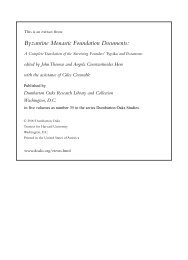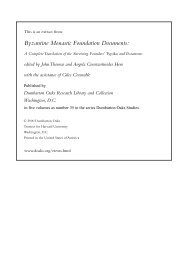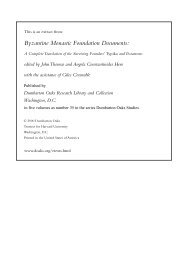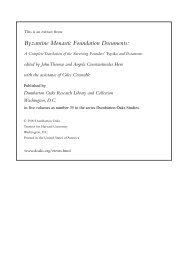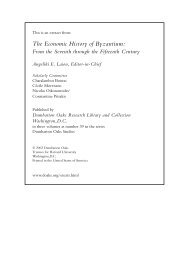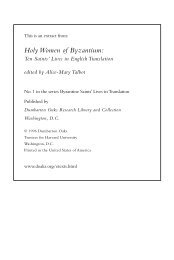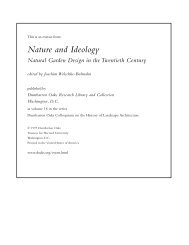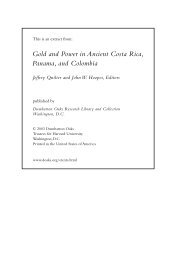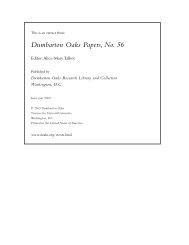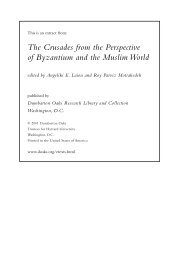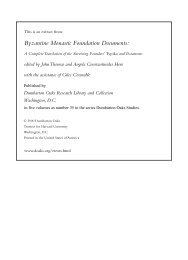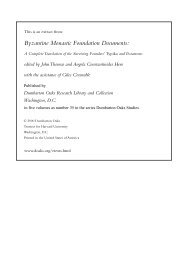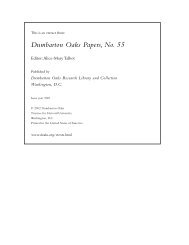The Zooarchaeological Record from Formative ... - Dumbarton Oaks
The Zooarchaeological Record from Formative ... - Dumbarton Oaks
The Zooarchaeological Record from Formative ... - Dumbarton Oaks
Create successful ePaper yourself
Turn your PDF publications into a flip-book with our unique Google optimized e-Paper software.
<strong>The</strong> <strong>Zooarchaeological</strong> <strong>Record</strong> <strong>from</strong> <strong>Formative</strong> Ecuador<br />
the coast in burial contexts at Ayalán (Hesse 1981) and El Azúcar (Reitz n.d.).<br />
<strong>The</strong>ir possible role in long-distance trade at Peñón del Río has been discussed<br />
(Stahl 1988).<br />
Limited evidence, particularly <strong>from</strong> highland sites, suggests the use of mammal<br />
bone in the manufacture of needles, awls, spatulas, scoops, and ladles, as<br />
well as musical instruments and ornamentation. In particular, carnivore tooth<br />
pendants are found in <strong>Formative</strong> assemblages. In Vegas context, Wing (1988)<br />
noted the relationship of Dusicyon teeth, particularly in larger communal grave<br />
contexts, which she considered to be offerings. She further suggested that wild<br />
fox populations may have been minimally controlled, and possibly even domesticated<br />
prior to the <strong>Formative</strong> (Wing 1988: 185). Certainly, we have seen<br />
the ritual disposal of other Ecuadorian domesticates in <strong>Formative</strong> dog burials,<br />
as well as post-<strong>Formative</strong> cuy and camelid grave associations in the southwestern<br />
lowlands.<br />
Clear evidence for the ritual use of animals during the <strong>Formative</strong> comes<br />
<strong>from</strong> the Jama valley of northern Manabí province. Zeidler (1988) has discussed<br />
the archaeological and religious context of feline effigy mortars uncovered<br />
in Terminal Valdivia context at the large ceremonial mound at San Isidro.<br />
Both feline and reptilian imagery have long been postulated to be included<br />
within the range of early decorative motifs found in the Northern Andean area<br />
(Damp 1982: 171; Stahl n.d.e: 168, 1985; Zeidler 1988: 250). Not surprisingly,<br />
nearby deposits also yielded burned fragments of the large tropical lowland<br />
jaguar (Stahl 1994: 189; Zeidler 1988: 264). Feline faunal remains, including<br />
those of the ocelot and puma, are found in different contexts throughout lowland<br />
and highland areas during the entire temporal span of <strong>Formative</strong> occupation.<br />
Perhaps the most dramatic example of ritual comes <strong>from</strong> recent excavations<br />
at the site of Capaperro, where one Terminal Valdivia burial yielded convincing<br />
evidence for shamanistic ritual. This feature included the close association of a<br />
miniature ceramic coquero; a polished green stone pendant; remains of a large<br />
fruit-eating bat (Artibeus sp.); and a ceramic figurine nestled within the mouth<br />
of an ocelot (Felis pardalis), whose snout rested on the midsection of a young<br />
woman (Zeidler et al. 1998).<br />
CONCLUSIONS<br />
<strong>The</strong> word precocious has crept into the literature on <strong>Formative</strong> Ecuador, and<br />
it is commonly used to underscore its early achievements. It is certainly my<br />
favorite descriptive term for the Ecuadorian <strong>Formative</strong>, as it richly conveys<br />
different meanings. It suggests to me the delight, astonishment, and mildly condescending<br />
amusement we experience when confronted with the gifted ex-<br />
189




